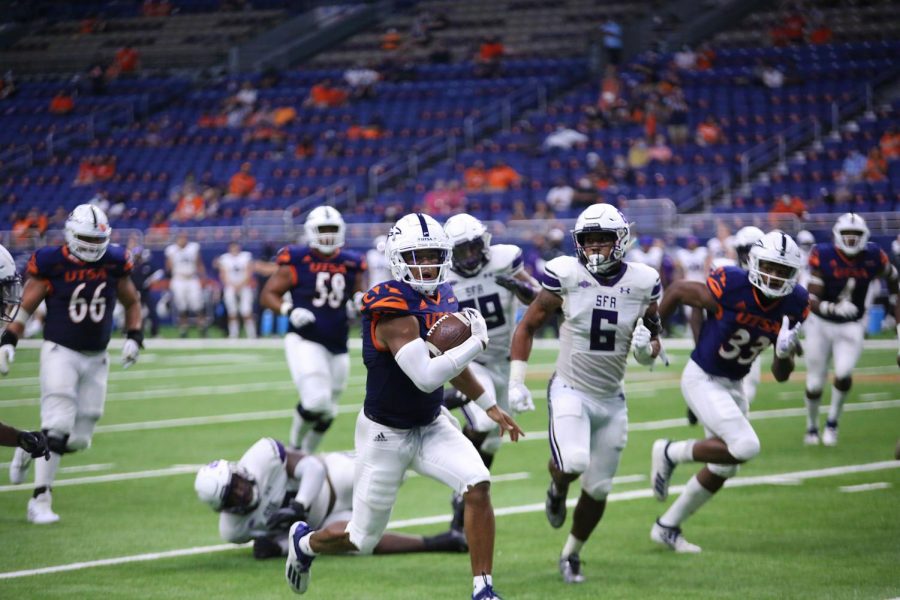The stats show it: UTSA football has improved considerably
Quarterback Frank Harris runs past Stephen F. Austin’s defense during the second game of the season. Harris’ scrambling ability contributes greatly to UTSA’s efficient rushing attack.
October 30, 2020
UTSA football has gotten off to a better start than anyone could’ve realistically expected in Coach Jeff Traylor’s first year. Sporting a 4-3 record on the year with wins over Texas State, Stephen F. Austin, Middle Tennessee and Louisiana Tech and competitive losses against UAB, BYU, and Army, UTSA has already looked much improved from last year’s final season under Frank Wilson. Like any team, UTSA has benefitted from some significant individual contributions on the field this season to help power them to their current position. This odd COVID-19-altered season has provided unprecedented television coverage and national attention on the ‘Runners program.
One important caveat to note before diving into these stats and the players’ current positions on the NCAA leaderboard is this: UTSA is one of only five teams to play seven games so far this season, so their rankings are slightly inflated.
Sincere McCormick has been the true engine of the UTSA offense so far this season. He currently leads the nation in rushing yards with 867, displaying the level of big-play ability and shiftiness that allowed him to enter the year with such high expectations.
Even when taking into account that McCormick has played more games than most other running backs this year, his per-game numbers are just as impressive. McCormick’s 123.9 yards per game would rank fourth in the nation when removing players who have only played one game so far this year.
McCormick has also demonstrated an ability to find the endzone this season, as he’s currently tied for 10th in the nation with seven rushing touchdowns so far. McCormick has been rewarded for his production by the UTSA coaching staff. He leads the nation in rushing attempts with 155, a large advantage over closest competitor Middle Tennessee quarterback Asher O’Hara’s 139 attempts. With his performance thus far, he is well on his way to exceeding last season’s totals, in which he only ranked 58th in rushing yards with 983 and was tied for 68th in rushing attempts with 177.
The UTSA defense currently ranks fourth as a team in tackles for loss, consistently showing an ability to get into the backfield and hit the running back behind the line of scrimmage. Of course, in order to achieve so much success as a team in this category, UTSA must be benefitting from some strong individual performances, and this is very much the case.
UTSA currently has four players inside the top 100 nationally in tackles for loss. Redshirt junior linebacker Trevor Harmanson is currently tied for 30th in the nation in tackles for loss with six, senior defensive linemen Jaylon Haynes and freshman linebacker Jamal Ligon are tied for 62nd with five and senior linebacker Charles Wiley is tied for 88th with four tackles for loss on the season.
Haynes is right on track to match the 12.5 tackles for loss he recorded last season, and Harmanson is well on his way to surpassing the 8.5 tackles he contributed last season. The emergence of Ligon, pressed into service due to injuries in the linebacking core at the start of the season, bodes well for the long-term strength of the defense with the impending graduations of Haynes and Wiley.
Arguably the biggest strength of UTSA so far this season, though, has been the special teams tandem of Hunter Duplessis and Lucas Dean. Prior to his blocked field goal in the third quarter of last week’s game against Louisiana Tech, Duplessis was sitting on an NCAA leading streak of 23 consecutively made field goals. Even so, Duplessis has been the model of consistency for UTSA this season; his 14 made field goals for the season lead the nation and even with his missed kicked last week, among kickers who have kicked in multiple games this year, his .933 field goal percentage is still good enough for sixth in the nation. He is also tied for third in the nation in total points scored with 62 and is tied with SMU’s Chriss Naggar for the national lead in points scored among kickers.
All of Duplessis’s numbers better last season’s effort in every way and show he’s making the most out of his last season here. Not to be outdone, Dean has been lights-out punting the football so far this season. He currently ranks second in the nation with 1,699 yards punting, good enough for an average of 45.9 yards per punt, a strong eighth place spot when removing punters who have only punted in one game this year. Both of these numbers far exceed last year’s numbers, in which Dean finished 42nd with 2,651 yards punting and was ranked outside the top 100 in yards per punt with 40.8.
This individual excellence all contributes to a team that’s seen marked improvement across the board. Last season, UTSA ranked 110th out of 130 teams in the nation, averaging 333.2 yards of total offense per game. This season, the UTSA offense is ranked 55th out of 101 teams, averaging 399.3 yards per game.
Defensively, UTSA has shown the same kind of improvement. After ranking 101st out of 130 teams with 449.8 yards allowed per game last season, UTSA now ranks in a tie for 56th out of 101 teams, allowing just 409 yards per game as a defense.
With all of these numbers in mind, it’s easy to see why UTSA has looked so much better on the field in Coach Traylor’s first year in comparison to Frank Wilson’s last year at the helm of UTSA. As UTSA gears up for the final stretch of Conference USA play in pursuit of a berth in the title game, look for these players to be massive factors in UTSA’s fortune.







